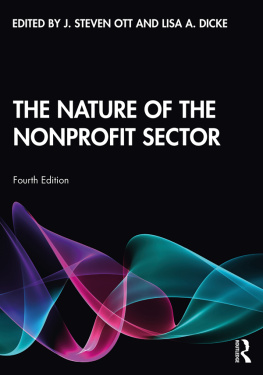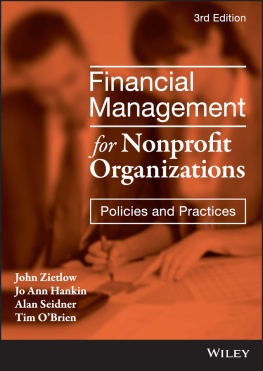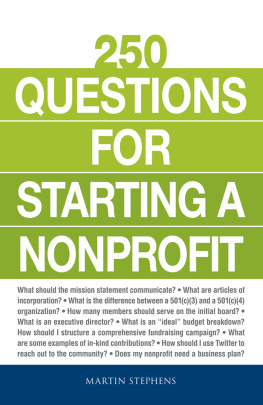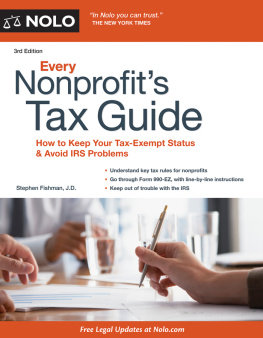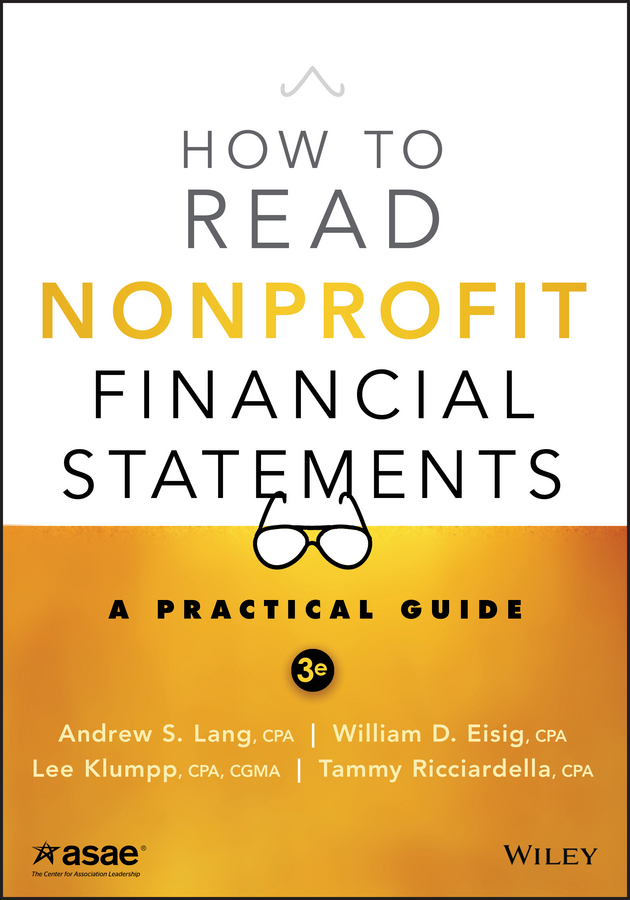
Praise for How to Read Nonprofit Financial Statements
How to Read Nonprofit Financial Statements: A Practical Guide equips nonprofit board members, the senior management team, and key stakeholders with the information they need to effectively understand their organization's financial statements. Through detailed, line-by-line analysis of each part of a financial statement, the authors have created a premier source of information that is easy to understand regardless of professional background.
Michael Bauer, Chief Financial Officer, World Wildlife Fund
Cover design: Wiley
Copyright 2017 by The American Society of Association Executives. All rights reserved.
Published by John Wiley & Sons, Inc., Hoboken, New Jersey.
Published simultaneously in Canada.
No part of this publication may be reproduced, stored in a retrieval system, or transmitted in any form or by any means, electronic, mechanical, photocopying, recording, scanning, or otherwise, except as permitted under Section 107 or 108 of the 1976 United States Copyright Act, without either the prior written permission of the Publisher, or authorization through payment of the appropriate per-copy fee to the Copyright Clearance Center, 222 Rosewood Drive, Danvers, MA 01923, (978) 750-8400, fax (978) 646-8600, or on the web at www.copyright.com. Requests to the Publisher for permission should be addressed to the Permissions Department, John Wiley & Sons, Inc., 111 River Street, Hoboken, NJ 07030, (201) 748-6011, fax (201) 748-6008, or online at www.wiley.com/go/permissions.
Limit of Liability/Disclaimer of Warranty: While the publisher and author have used their best efforts in preparing this book, they make no representations or warranties with respect to the accuracy or completeness of the contents of this book and specifically disclaim any implied warranties of merchantability or fitness for a particular purpose. No warranty may be created or extended by sales representatives or written sales materials. Practice and accounting standards may change. Additionally, the advice and strategies contained herein may not be suitable for your situation. You should consult with a professional where appropriate. Neither the publisher nor the author shall be liable for damages arising therefrom.
For general information about our other products and services, please contact our Customer Care Department within the United States at (800) 762-2974, outside the United States at (317) 572-3993 or fax (317) 572-4002.
Wiley publishes in a variety of print and electronic formats and by print-on-demand. Some material included with standard print versions of this book may not be included in e-books or in print-on-demand. If this book refers to media such as a CD or DVD that is not included in the version you purchased, you may download this material at http://booksupport.wiley.com. For more information about Wiley products, visit www.wiley.com.
Library of Congress Cataloging-in-Publication Data:
Names: Lang, Andrew S., author. | Eisig, William, author. | Klumpp, Lee, author. | Ricciardella, Tammy, author.
Title: How to read nonprofit financial statements: a practical guide/Andrew Lang, William Eisig, Lee Klumpp, Tammy Ricciardella.
Description: Third edition. | Hoboken: Wiley, 2017. | Revised edition of How to read nonprofit financial statements, 2010. | Includes index.
Identifiers: LCCN 2016055393 (print) | LCCN 2016056037 (ebook) | ISBN 9781118976692 (paperback) | ISBN 9781118976715 (epdf) | ISBN 9781118976708 (epub)
Subjects: LCSH: Nonprofit organizationsUnited StatesAccounting. | Financial statementsUnited States.
Classification: LCC HF5686.N56 L36 2017 (print) | LCC HF5686.N56 (ebook) | DDC 657/.3dc23
LC record available at https://lccn.loc.gov/2016055393
Preface
If you are familiar with the earlier versions of this publication, you know how valuable a resource this book is to readers of nonprofit financial statements. This updated edition of the publication has been expanded and incorporates even more information that will make this a must-have resource.
This edition has been updated to reflect the new requirements of the Financial Accounting Standards Board (FASB) Accounting Standards Update (ASU) 2016-14, Not-for-Profit Entities (Topic 958): Presentation of Financial Statements of Not-for-Profit Entities, which will be effective for most nonprofits for fiscal years beginning after December 15, 2017. The provisions of the ASU can be adopted early if a nonprofit chooses to do so.
The illustrations in this book are designed to provide readers with both the format of nonprofit financial statements before the adoption of ASU 2016-14 as well as the format once a nonprofit adopts the provisions of ASU 2016-14. The illustrations highlight best practices as well as the required changes outlined in the ASU. These illustrations provide a great resource for those trying to read and interpret nonprofit financial statements as well as for those who are responsible for designing and preparing nonprofit financial statements.
A new chapter has been provided that discusses reserves. This is a challenging topic and one that many organizations struggle with, and unfortunately there isn't a single, definitive answer. There are certain considerations and other factors, however, that an organization should analyze in making an assessment regarding appropriate reserves.
This edition provides a new section discussing general financial analysis that provides greater insight into what readers of nonprofit financial statements should be looking for to enable them to satisfy their fiduciary responsibility whether they are a board member, audit committee member, advisor, or internal CEO or CFO. The section also provides some of the more common ratios that can be used to obtain information about the financial condition of a nonprofit organization. This information should be used by all readers and preparers of nonprofit financial statements to ensure the financial statements are designed to provide an accurate depiction of the nonprofit organization's financial position, activities, and results.
This edition also includes a new chapter on benchmarking to assist nonprofits in making comparisons to other nonprofit organizations.
A glossary is included that will assist readers in identifying the meaning of specific terms used in nonprofit accounting and financial statements that can be referred to time and time again.
Learning Objectives
Every educational effort should have a specific focus. This text has been designed so that once you have completed it, you will be able to:
- Name and understand the primary purpose of a nonprofit's basic financial statements.
- Recognize best practices in the presentation of financial information in nonprofit financial statements.
- Understand the significance of the independent auditor's report and be able to recognize an unmodified (clean) opinion and other types of audit opinions.
- Understand the role of the footnotes in financial statements and the purpose they serve.
- Extract and interpret certain financial information from each of the basic financial statements.
- Understand the basic accounting rules that apply specifically to nonprofit organizations.
- Understand the new financial statement presentation changes required by ASU 2016-14.
- Understand the method of assessing the need for reserves.
- Familiarize yourself with common financial ratios that are useful in assessing the financial health of a nonprofit organization.
Next page





